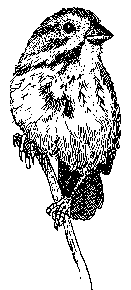Monitoring bird populations in Mount Revelstoke National Park
- by Michael Morris, Mount Revelstoke and Glacier National Parks
- May 1999
In terms of numbers of species (183), birds are the most diverse of any group of vertebrates occupying the are of these two national parks. This diversity peaks during the breeding season from May to August, after which about half of the bird species living in our parks in the summer migrate to the neotropics (southern United States, Mexico, Central and South America) for the winter.
Avian research and monitoring programs near Revelstoke contribute information for monitoring the effects of world wide environmental problems including global climate change, habitat alteration, and widespread pollution of terrestrial and aquatic ecosystems. Breeding birds in Mount Revelstoke and Glacier National Parks are part of a global ecosystem which is under pressure here and elsewhere, beyond the boundary of national parks, but not beyond our influence.
Research and monitoring
 The Skunk Cabbage Nature Trail in Mount Revelstoke National Park is the only site in British Columbia where breeding songbird populations are monitored on a regular basis through bird banding. The self-guided trail features a boardwalk with observation stations that meanders through a swampy, riparian area, a productive locale for breeding birds. Since the station opened in 1993, 1082 individuals of 45 bird species have been banded. The leader in fidelity to this site is a MacGillivary’s Warbler, so far recaptured each year of operation.
The Skunk Cabbage Nature Trail in Mount Revelstoke National Park is the only site in British Columbia where breeding songbird populations are monitored on a regular basis through bird banding. The self-guided trail features a boardwalk with observation stations that meanders through a swampy, riparian area, a productive locale for breeding birds. Since the station opened in 1993, 1082 individuals of 45 bird species have been banded. The leader in fidelity to this site is a MacGillivary’s Warbler, so far recaptured each year of operation.
This site contributes to a North American study of landbird populations trends, known as MAPS (Monitoring Avian Productivity and Survivorship). The MAPS program, initiated by the Institute of Bird Populations in California, is a research program that provides data on the productivity (birth rate) and survivorship (death rate) of landbirds. This data is important because other North American bird studies have identified serious declines, particularly neotropical migrants in eastern North America. The situation in western North America is unclear.
The process of identifying migratory patterns and specific breeding locations is helped by the development of a new technique that uses isotopic indicators. Stable isotopes are naturally occurring forms of an element that differ in molecular weight. Variation in the relative abundance of an isotope is captured in feathers grown by breeding birds. Each different isotopic composition is specific to the environment where the feathers were grown. This can be measured, thus marking breeding birds with a kind of chemical fingerprint. Researchers may someday be able to link specific breeding grounds to individual birds found at points along their migration path or on their wintering grounds using this method.
Role of volunteers
Though initiated and guided by Parks Canada and the Canadian Wildlife Service, this work is carried out principally by volunteers, all members of the Friends of Mt. Revelstoke and Glacier. They set up mist nets to capture and band the birds in the area, noting the species, age, sex, breeding status and general condition of the birds captured. Work begins at 4:00 in the morning! Great care is taken when handling the captured birds. Though the crew is made up of volunteers, they are now expert in the handling of birds and have completed the certification required to handle birds covered by international agreements.
Their success has lead to the establishment of a second monitoring station near Revelstoke, British Columbia, to monitor migrating birds that use the Columbia River valley as a travel corridor. Along with other stations across North America, these investigations may someday answer broad ecosystem level questions such as where birds are coming from, where are they going, and how stable are their populations? To better accomplish this, more stations are needed in the breeding areas of Canada and Alaska and in the wintering grounds of Central and South America.
Habitat concerns
In mountain regions, valley bottoms are the most productive habitats and contain the greatest diversity of plant and animal species. In much of British Columbia, these areas make up a small part of the landscape and are poorly represented among the region’s protected areas. Yet they are critical for most of the wildlife we consider typical of interior British Columbia. Additionally, the cumulative effects of hydro-electric reservoirs, transportation routes, and forestry have reduced the area previously available to breeding birds in this part of the world.
Data from this monitoring program is used locally in environmental impact assessments and internationally by the Canadian Wildlife Service and the Institute for Bird Populations which work with foreign countries to ensure protection to crucial wintering grounds. Knowing which areas provide key habitat for target or vulnerable species will aid international conservation efforts to address declining neotropical migrant populations in relation to the disturbance and destruction of their summer and winter habitats.
For more information…
For more detail on the monitoring program refer to:
Dunderdale, S. 1999. Monitoring Breeding Landbirds in Mount Revelstoke National Park, British Columbia.
Parks Canada, Skunk Cabbage MAPS Station 1993-1998.
Jarvis, J. and S. Dunderdale. 1999. Monitoring Forest Birds by Migration Counts in the Columbia Basin.
Parks Canada, Columbia River-Revelstoke Migration Station 1998 Progress Report.

